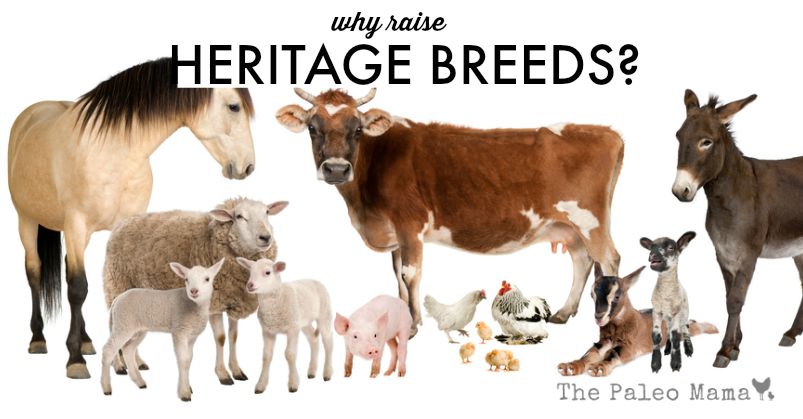

Gather Heritage Farm, our new 10-acre farm we recently purchased, has chosen to concentrate on growing tomorrow from the heritage of yesterday. We are concentrating on choosing heritage breeds (rare livestock breeds) for our homestead menagerie, and on filling our gardens with heritage and heirloom plants. We understand the importance of heritage—because we are the benefactors of our own rich heritage from our ancestors and I’m excited to answer all the common questions on why raise heritage livestock breeds.
Martin and Mary Kidder, my ancestral grandparents from the 1800s, also raised plants and animals on a farm probably much like ours. I have her diary from 1879, and find I can draw inspiration from the record of how she lived her life. Farming was hard then, probably much harder than anything I will have to face. On one particularly busy day she wrote:
Martin gone down to ditching and I have been into almost everything. Cleaning house. Taking care of butter. Doing all the chores both outdoors and indoors. Making tomato preserves, and last—but not least—drawing water out of the well. It was not no little chore either, but done. But O my how my back aches. Good-bye, I am going to bed.
There have already been nights when I felt exactly like that—my back ached, but my chores were done and all I wanted to do was to crawl into bed. But her heritage to me is much more valuable than identifying with her aching back. Her indomitable spirit is what gives me strength. On June 12th, her 28th birthday, she wrote:
How swiftly time onward doth roll and brings us nearer eternity. May I not have to at the close of another year look back and regret, but may it be a year well spent.
She kept that spirit on good days and bad days. On January 7th, she wrote:
O dear, a little bad luck. Our nice fat hog is dead. Think it was blind staggers ailed him. Makes us feel rather blue. But then it might have been worse. Let us count our blessings.
So for us—the Ritz family of Gather Heritage Farm—raising heritage plants and animals allows us to help preserve essential genetic traits, things like self-sufficiency, foraging ability, maternal instincts, and resistance to diseases and parasites. Heritage breeds store a wealth of genetic resources that are important for tomorrow—heritage animals and plants are the seed of yesterday that will build a better tomorrow.
Let me introduce you to some of our current heritage-laden animal family members and some of the other animals we chose to raise.
Silver Appleyard Ducks
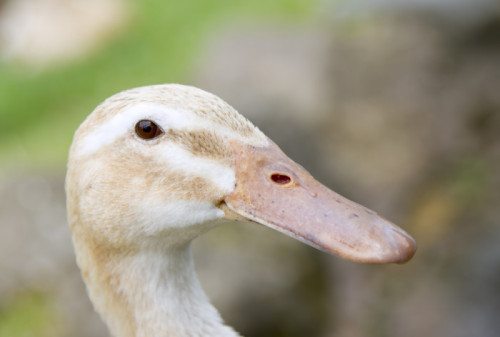
We have eleven Silver Appleyard ducks, a critically endangered breed of ducks. In a 2000 census of domestic waterfowl in North America, only 128 Silver Appleyard ducks were reported. The Silver Applewood is named after Reginald Appleyard, who developed it in England. His ambition was to create a very attractive breed of large duck that would also be a prolific producer of white, large eggs.
According to the American Livestock Breeds Conservancy, “there is a critical need for more conservation breeders of Appleyards. Their excellent laying ability, meaty carcasses, and lovely plumage make them a great addition to any small farmstead.” (Source)
American Buff Geese
We have two American Buff geese, a critically endangered breed, which we hope to raise and breed se we can help to preserve this wonderful breed. The American Buff goose was developed in North America and is descended from the wild Greylag goose, found in Europe and Northern Asia.
The American Buff geese, unlike other geese, are very calm and have a wonderful disposition—qualities I find important in animals and humans alike. They are good parents, attending well to their goslings. These attributes make the breed well suited for the average home flock. They are very smart, very friendly, and very affectionate.
Heritage Breed Chickens
Chantecler (critically endangered)- The Chantecler originated in the Quebec Province of Canada and is a fine example of a dual-purpose breed. This breed is noted for its ability to withstand harsh winters. The lady I purchased my Chanteclers from mentioned that they will continue to lay large brown eggs when in the coldest of winters.
Rhode Island Red (recovering)- these chickens are American’s best known breed is the most successful dual purpose bird, and remains an excellent farm chicken.
Black Java (threatened) -the Java is considered the second oldest breed of chicken developed in America. The Java is a great homesteading bird and thrives in a free range environment.
Orpington – this dual purpose American chicken breed bird is reaching the “recovering” status according to the Livestock Conservancy. They have a fast growth rate which makes them an excellent breed for meat, and also lay large light to dark brown eggs.
Freedom Ranger Meat Chickens
Although not a true heritage breed, Freedom Ranger Chickens are a hybrid breed (a cross between commercial and heritage breeds) and a good alternative to the fast-growing commercial Cornish Cross. This breed is perfect for free range environments. They are active and robust birds with tri-colored feathers, and thrive in foraging and pasture environments. They produce tender, succulent meat with more yellow omega 3 fat and less saturated fat than fast growing breeds.
Freedom Ranger breeding stock is imported from the regions of Burgundy and Brittany (France). The genetic stock is derived from the American and European old heritage breed of chicken and was developed in the early 1960s to meet the highest standards of the French Label Rouge Free Range program. They are said to have a superior taste because they are a slower growing bird than the fast-growing commercial brands.
Turkeys
Narragansett (threatened) – this turkey is a descendant of the English and European colonists beginning in the 1600’s. Narragansett turkeys have traditionally been known for their calm disposition, good maternal abilities, early maturation, egg production, and excellent meat quality. As recently as 50 years ago, they were well regarded for production qualities.
Royal Palm (watch list) – The Royal Palm is a strikingly attractive and small-sized turkey variety. They are white with a sharply contrasting, metallic black edging on the feathers. Royal Palms are active, thrifty turkeys, excellent foragers, and good flyers. Standard weights are 16 pounds for young toms and 10 pounds for young hens.
Nubian Goats
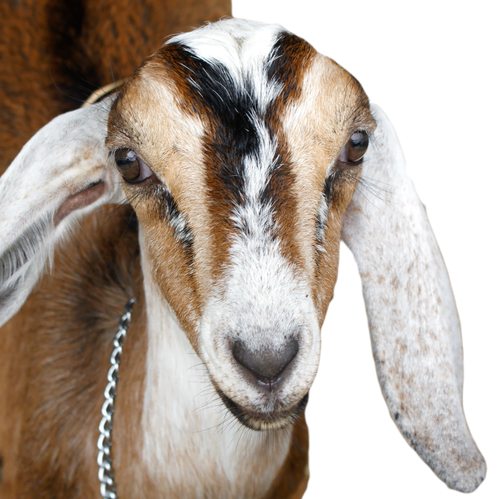
Although not a heritage goat breed, we chose our Nubian goats because they produce lots of yummy milk high in butterfat—and because they are just so darn cute. The Nubian is a relatively large, proud dairy goat of mixed origin. The ancestors of today’s Nubian have African and Indian heritage, developed further in England, where they are known as Anglo-Nubians. They have long, floppy, wide ears that are longer than their heads.
They are very intelligent and personable, and love the attention you give to them. They have fun personalities, and can be very talkative. They are natural escape artists, so you need strong fencing. They provide lots of milk, and I’ve made wonderful tasting cheeses and creamy soaps with their milk.
Alpine Goats
Our Alpine goats originated in the Swiss Alps, and are excellent milkers with large, well-shaped udders. Alpines first appeared in America in 1922. They are hardy and agile, and adapt to just about any climate. Like our Nubians, they have a talent for escape, so sturdy fencing is needed. We count on the services of Esme, our LGD, to watch over and tend to the antics and wandering habits of our family goats.
Because of their fun colors, milk output, and friendly dispositions, raising our goats has become a Gather Heritage Farm delight.
Great Pyrenees Livestock Guardian Dog
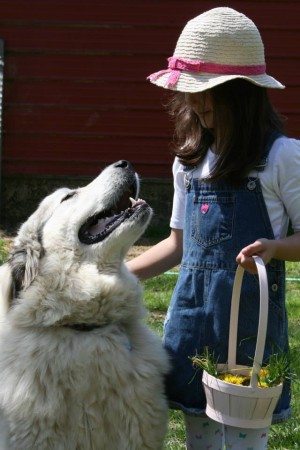
Esme, our Great Pyrenees LGD, has developed into a fantastic guardian dog for our barnyard menagerie. Great Pyrenees are one of the oldest dog breeds in the world. They were bred as dogs of war and then used during peacetime as sheep guarding dogs. They are one of the least aggressive of the large guardian dogs (LGD), so often people cherish them as family dogs. They are regal, independent and aloof compared to other dogs breeds, traits necessary to spend days alone guarding flocks.
Investing in a Livestock Guardian Dog was the BEST decision we made when we started our homestead. We found our puppy on Craigslist and she came from a working farm with working parents. We have invested hours of training into her and I couldn’t imagine our farm without her. The ultimate satisfaction of this investment comes when I look out the window and I see her laying down near where the goats are grazing and our free-range chickens are pecking happily in the dirt beside her.
As you can tell, Gather Heritage Farm takes heritage very seriously. We know that one of the best ways to ensure a better tomorrow is to plant the heritage of yesterday firmly in the soil of today and watch it bloom in the harvest of tomorrow.
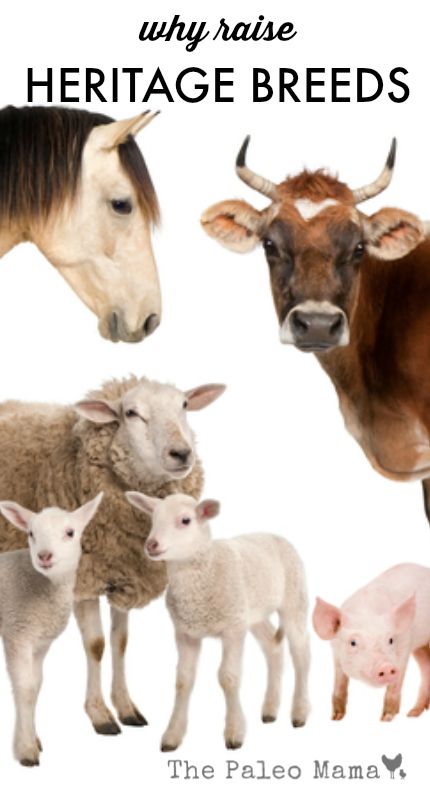
Jackie – what a great and timely article! I’m actually in the process of looking for a small farm (about 10 acres) in the VA area after recently selling a larger one (117 acres) in NY. My goal is to find a place with a longer growing season (it’s tough in NYS where last frosts were as late as June and firsts sometimes coming in early September), work to get off the grid a bit and enjoy livestock, produce and a more easily manageable property while maintaining the natural lifestyle I had come to enjoy. Your tips on heritage breeds are fabulous (I too believe in doing what I can to help prevent losing what’s left of some old greats – did it with the produce business in NYS). Thanks so much for an article rich with ideas, arguments and experience.
Jackie,
I really would like some Chanticlers
I have been looking for a while, people say you can order them online. However i am only able to find white ones. Where did you get yours and which ones do you have?